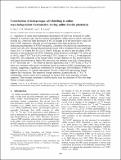Contribution of isotopologue self-shielding to sulfur mass-independent fractionation during sulfur dioxide photolysis
Author(s)
Lyons, J. R.; Ono, Shuhei; Whitehill, Andrew Richard
DownloadOno_Contribution of.pdf (606.6Kb)
PUBLISHER_POLICY
Publisher Policy
Article is made available in accordance with the publisher's policy and may be subject to US copyright law. Please refer to the publisher's site for terms of use.
Terms of use
Metadata
Show full item recordAbstract
Signatures of sulfur mass-independent fractionation (S-MIF) are observed for sulfur minerals in Archean rocks, and for modern stratospheric sulfate aerosols (SSA) deposited in polar ice. Ultraviolet light photolysis of SO[subscript 2] is thought to be the most likely source for these S-MIF signatures, although several hypotheses have been proposed for the underlying mechanism(s) of S-MIF production. Laboratory SO[subscript 2] photolysis experiments are carried out with a flow-through photochemical reactor with a broadband (Xe arc lamp) light source at 0.1 to 5 mbar SO[subscript 2] in 0.25 to 1 bar N[subscript 2] bath gas, in order to test the effect of SO[subscript 2] pressure on the production of S-MIF. Elemental sulfur products yield high δ[superscript 34]S values up to 140 ‰, with δ[superscript 33]S/δ[superscript 34]S of 0.59 ± 0.04 and Δ[superscript 36]S/Δ[superscript 33]S ratios of −4.6 ± 1.3 with respect to initial SO[subscript 2]. The magnitude of the isotope effect strongly depends on SO[subscript 2] partial pressure, with larger fractionations at higher SO[subscript 2] pressures, but saturates at an SO[subscript 2] column density of 10[superscript 18] molecules cm[superscript −2]. The observed pressure dependence and δ[superscript 33]S/δ[superscript 34]S and Δ[superscript 36]S/Δ[superscript 33]S ratios are consistent with model calculations based on synthesized SO[subscript 2] isotopologue cross sections, suggesting a significant contribution of isotopologue self-shielding to S-MIF for high SO[subscript 2] pressure (>0.1 mbar) experiments. Results of dual-cell experiments further support this conclusion. The measured isotopic patterns, in particular the Δ[superscript 36]S/Δ[superscript 33]S relationships, closely match those measured for modern SSA from explosive volcanic eruptions. These isotope systematics could be used to trace the chemistry of SSA after large Plinian volcanic eruptions.
Date issued
2013-03Department
Massachusetts Institute of Technology. Department of Earth, Atmospheric, and Planetary SciencesJournal
Journal of Geophysical Research: Atmospheres
Citation
Ono, S., A. R. Whitehill, and J. R. Lyons. “Contribution of Isotopologue Self-Shielding to Sulfur Mass-Independent Fractionation During Sulfur Dioxide Photolysis.” Journal of Geophysical Research: Atmospheres 118, no. 5 (March 16, 2013): 2444–2454. Copyright © 2013 American Geophysical Union
Version: Final published version
ISSN
2169-8996